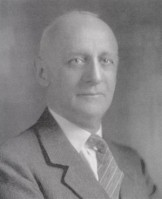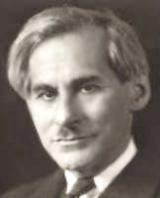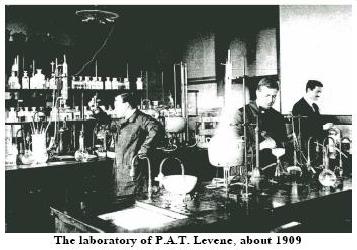
The Institute and Its Mission
Here is an institution whose value touches the life of every man that lives…Who has not felt the throbbing of desire to be useful to the whole wide world? Here at least is a work for all humanity, which fully satisfies and fills that glorious aspiration…Your vocation goes to the foundations of life itself...2
The Rockefeller Institute's purpose was straightforward - to give scientists the resources to do research in medical fields. It had a broader aim than the European institutes, most which focused primarily on infectious diseases. Rockefeller aimed at the full scope of medical practice. In addition to studying infectious disease, its scientists would explore surgical techniques (paving the way for organ transplants) and would begin research into cancer (Peyton Rous, a Hopkins grad doing research at Rockefeller, discovered in 1911 that a virus can cause cancer, and half a century later he won a Nobel Prize for his efforts). They also did the basic work that would lead to one of the great scientific feats of the 20th century - the mapping of the DNA molecule.
Welch picked a protégé, Simon Flexner, to head the new institute. Flexner created the institute in his mold - "sharp, edgy, cold."3 He was described as rough, brilliant and intimidating. He was feared, by some of the best scientists in the world. He demanded only the best to work for him, and would dismiss those whose work he believed did not match his standards. But he could be patient and nurturing when he saw promise, and he gave wide latitude when he saw a researcher with real talent. He also valued openness and debate, friction and disagreement, and he sought out individualists, mavericks unafraid to think in new directions, and encouraged regular, lively exchanges of ideas. His goal was to create not an institute but a living organism, and the result was an environment that was equally demanding and exciting, provocative and creative.
From the beginning, the new institute regularly made headlines, not just in America but internationally. It immediately had a huge impact on the scientific world and on the public as well. Accomplishments were publicized, often and with much fanfare. The press loved Flexner and his institute, and he loved them back. Although it had its critics who mocked the publicity machine, Rockefeller quickly became to research what the Hopkins had become to medical study and training - the place to be for a scientist wanting to make a name for themselves in research. The Rockefeller Institute would be involved in, and often at the center of, seemingly every significant medical development in America for some time to come.
This era, the late 19th-early 20th century, has been referred to as the golden age of American medicine. Major discoveries were occurring seemingly every day, vaccines and treatments for some of humanity's deadliest diseases were appearing, and the biological sciences were the center of the medical universe. Many of the processes for preparing cultures, conducting research, treating infectious disease, etc., that were developed during those early days, are still in practice today; in some cases the early researchers achieved results with patients that were superior to more modern pharmaceutical approaches. The great plagues that had stalked mankind for centuries - smallpox, cholera, typhoid, bubonic plague, yellow fever - were being contained and lives were being saved from epidemic by the millions.
Ida Rolf, Chemist
This was the scientific culture in which Ida Rolf started her professional career. She had earned her undergraduate degree from Barnard College in 1916, and officially began working as a technician at the Rockefeller Institute in 1917. At about the same time she also began her doctoral studies at Columbia University. So she was accepted as a biological chemist, at the zenith of the biological science-driven revolution in scientific medicine, at the institution that was ground zero for laboratory research in America, arguably the most prestigious place in the world for a scientist to work.
It is commonly thought that she was accepted because of a lack of qualified men at the time - the boys were off at war and so women were given a chance to study and practice in the scientific arena. This may partly explain her acceptance to Columbia (she didn't begin her studies at Columbia until late 1917, after the U.S. entry into the war), but probably not to Rockefeller itself. She apparently had some connection to the Rockefeller family of organizations in New York City while still an undergraduate at Barnard. An April 3, 1916 entry in the Barnard College newspaper mentioned Ida Rolf, then a senior soon to graduate, as an alternate for a fellowship, and noted that she was "doing work in chemistry at the Rockefeller Foundation"4. The Rockefeller Foundation was a charitable foundation, also established by the Rockefeller family, which at the time focused on the sciences, public health and medical education. It is not known whether she actually worked for the Foundation, or whether the entry was a misstatement and she already was doing work for the Institute. But at any rate, this was over a year before the United States entered World War 1.
Rockefeller had many women employees at the time, but most were apparently only in lower or entry-level positions. It was much less likely for a woman to advance up the rungs of the scientific ladder. In 1918 Ida Rolf returned to Barnard to talk to undergraduates about employment at Rockefeller. She reported that "…in all the laboratories women are employed without discrimination and hold many responsible positions."5
However, in "A History of the Rockefeller Institute", George Washington Carver makes almost no mention of women scientists in that early era. All of the department heads and numerous associates and assistants are mentioned, along with their work, and there is scarcely any mention of any woman. In a description of the head of the Chemistry laboratory, Carver notes "approximately 40 men"6 passing through his lab during his tenure. The author describes an organization that was almost exclusively the domain of men, at least at the level of researchers.
Most of the women who were employed at Rockefeller very probably began either in administrative positions or started as technicians in the laboratories. Moving up was the challenge. Ida Rolf was apparently one of the very few who did advance.
Dr. Rolf was officially first listed as an employee at the Institute sometime in 1917. She also began her studies in Biological Chemistry at Columbia in late 1917. At the time, Rockefeller was basically functioning as a postdoctorate university. Almost all the scientists already had their PhD's before being hired. However, like Ida Rolf, several others began as technicians and used their work at Rockefeller to earn PhD's from Columbia. Most scientists swould spend a few years - five to seven at most - at the Institute, then leave to take University positions or work in industry. Only a very few would become full Members with lifetime tenure.
 Simon Flexner |
 Phoebus Levene |
He had emigrated to the U.S. in 1893 and, like Ida Rolf, enrolled in Columbia and began his research in chemistry. Over the course of his professional life, he contributed a huge body of research in biological chemistry, across several areas of interest. He is most known for two major contributions (and one major mistake he made) with regard to the discovery and understanding of the DNA molecule.
The Levene Laboratory
Levene had another quality that may have eventually led to Ida Rolf's restlessness at Rockefeller. All the department heads had full control over their laboratories. Some gave their assistants and associates wide leeway to follow their own research interests. Levene was at the other extreme - his assistants were expected to do only research that Levene himself found compelling. They had little freedom to explore their own interests; as a result, he developed fewer prominent scientists than the other department heads. This led Flexner to express concern in 1919 that Levene's scientists "…were not being trained for independent work."8 His department had a lot of churn - scientists would leave, looking for other opportunities. As popular and well-liked as he was, and despite his reputation as an excellent teacher, he didn't have a gift for developing talent.

Dr Rolf was named as an assistant in 1918. In 1920 she received her PhD from Columbia and in 1922 she was promoted to Associate, the highest non-tenured position for a scientist at Rockefeller. She remained as an Associate until her departure. From 1919 to 1927, she published fifteen research articles that are known, in addition to her doctoral dissertation, mainly on two phosphatides, lecithin and cephalin.
Dr. Rolf's role, through most of her time at Rockefeller, was to further explore the structure and nature of lecithin and its chemical cousins (the phosphatides were one of Levene's personal areas of interest). It was the step-by-step, detailed work of laboratory science - how to extract lecithin efficiently from egg yolks, how to more exactly determine its chemical structure. Her published papers are, in a word, dry (one scientist who has read them, describes them as a wonderful cure for insomnia).
Rolf's research was all co-authored with Levene - his name always appeared above hers in their papers. It was common at the time to have heads of laboratories put their name on any research that came out of their laboratory, regardless of whether the laboratory head had actually participated in the study. So it is not know whether he actively worked with her in her published research or simply acted as supervisor.
(1) (2) (3) (4) (5) (6) (7) (8)
